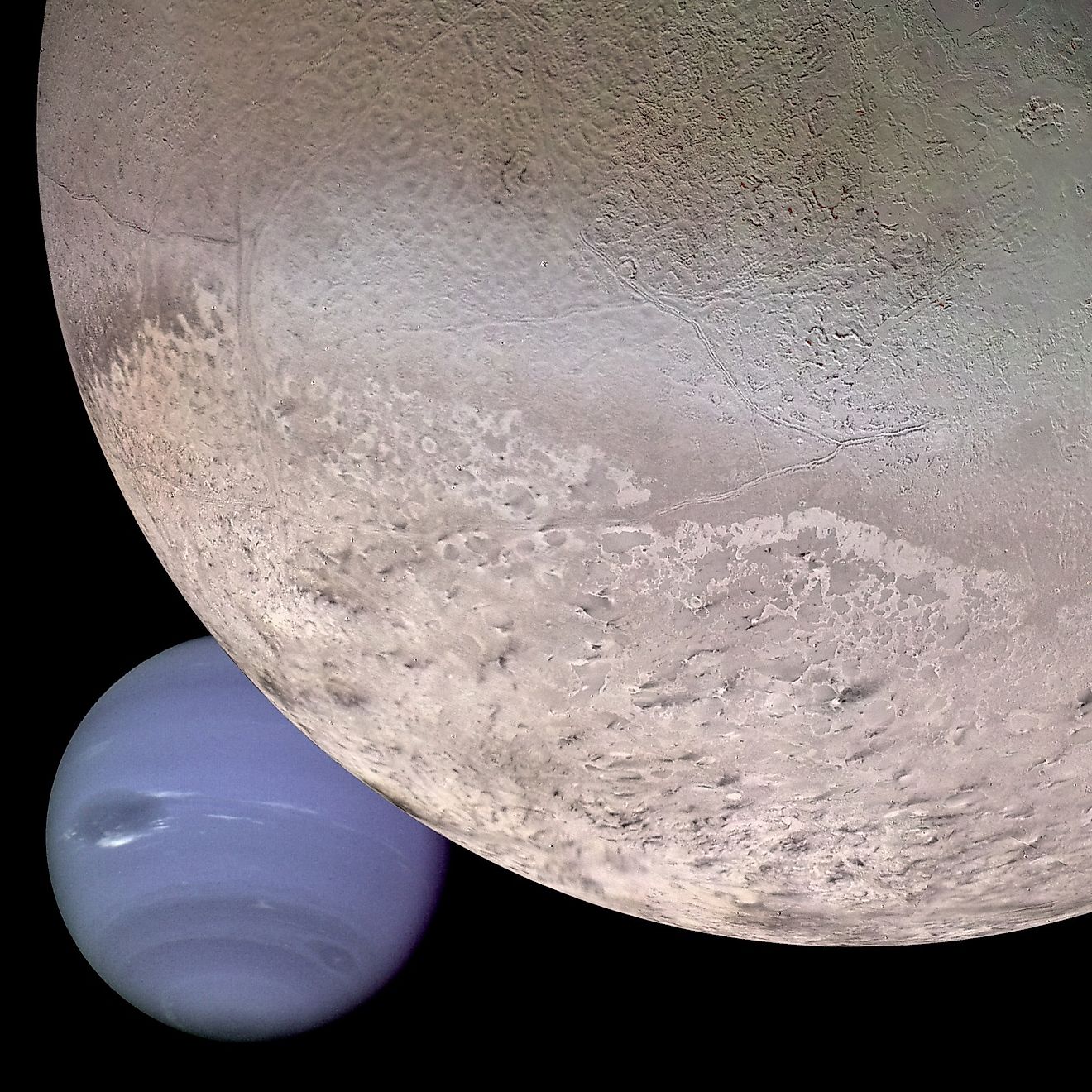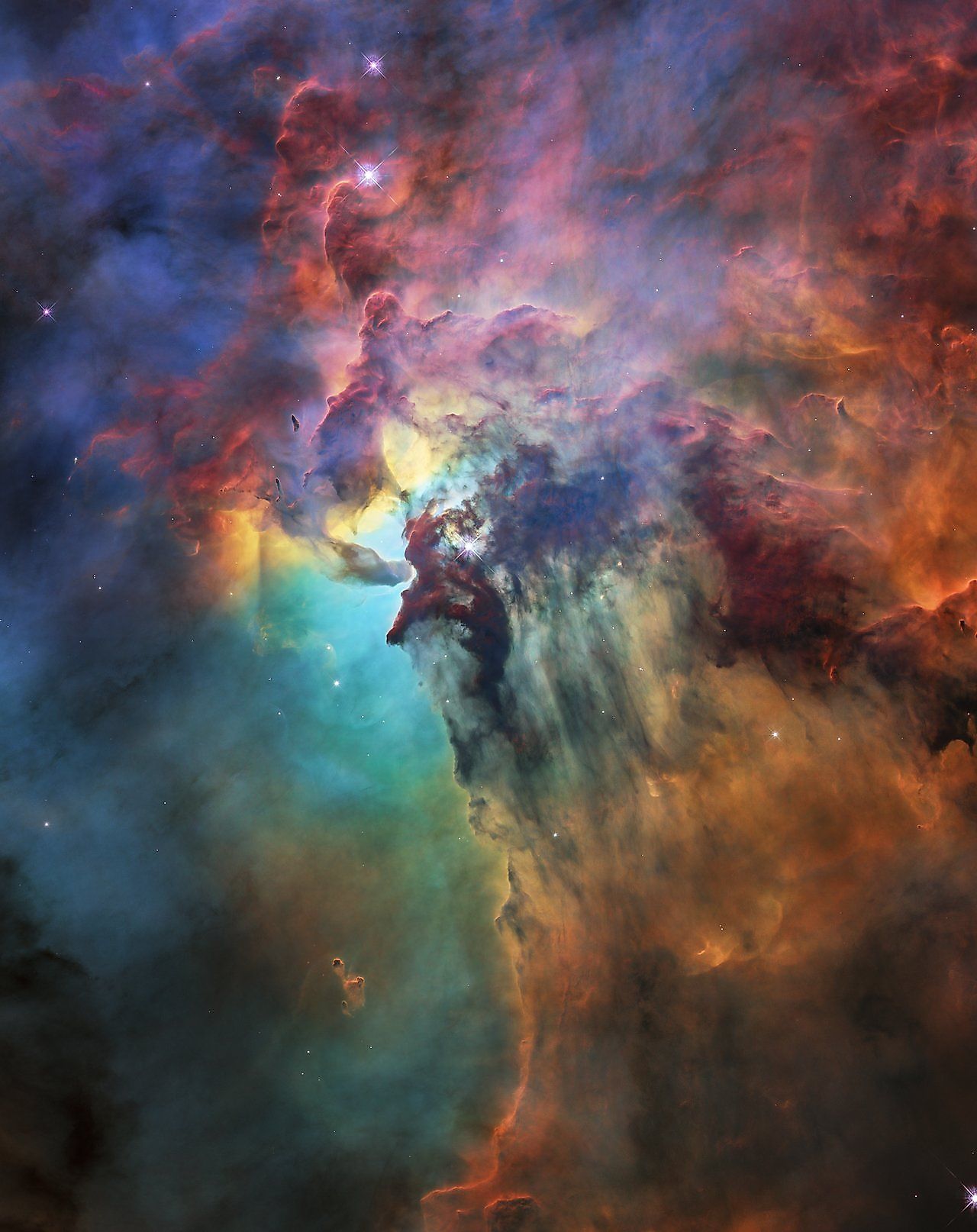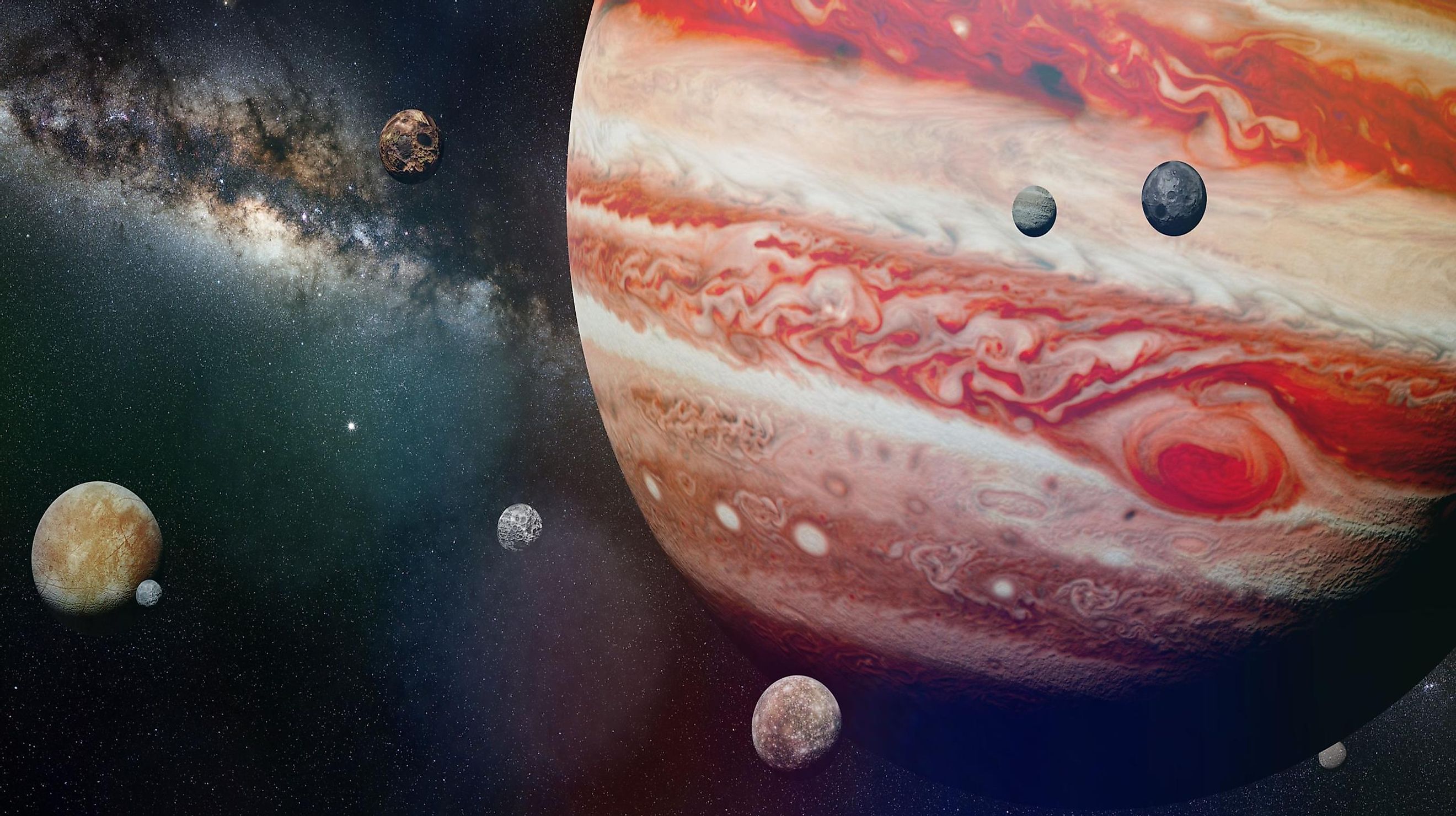
Jupiter
Jupiter is the largest and most massive planet in the solar system. Jupiter is eleven Earths across with a diameter of 88,846 miles (142,983 kilometers). By volume, Jupiter reveals itself as the true king of the planets. You could fit every other planet within Jupiter and still have some volume left over.
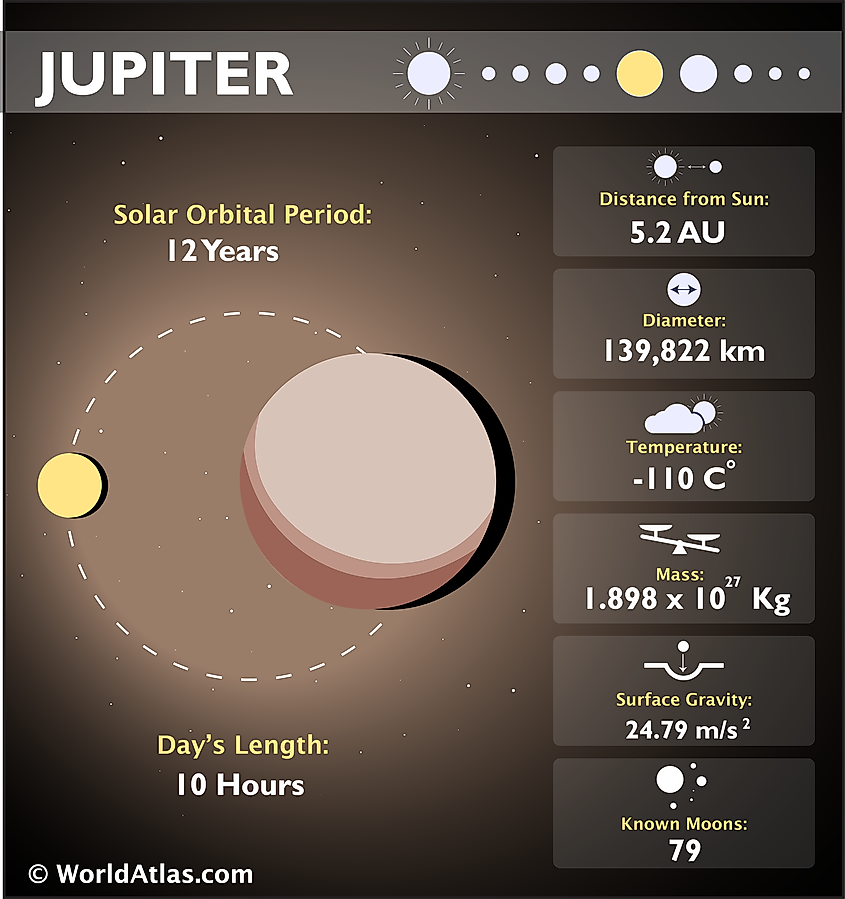
Important Facts About Jupiter
Like the sun, Jupiter is primarily composed of hydrogen and helium elements. Jupiter orbits the sun at an average distance of 484-million miles (778-million kilometers). At such a vast distance from the sun, Jupiter receives very little heat from the sun. As a result, its upper atmosphere is very cold, having an average temperature of minus 186 degrees Fahrenheit. However, the interior of Jupiter experiences far higher temperatures that generate vast storms and fast winds. Winds in Jupiter's atmosphere can reach 250 mph (402 km/h). Jupiter's atmosphere is about 5,000 miles (8,046 kilometers) thick and consists primarily of hydrogen and small amounts of helium and methane. Beneath these gases is an ocean of hot liquid hydrogen. Jupiter's liquid layer of hydrogen is about 30,000 miles (48,280 kilometers) thick. Beneath this, scientists believe there is a layer of water and ammonia and a rocky core that would measure around 4,200 miles (6,759 kilometers) in diameter. Deep within Jupiter, the pressures reach 45 million times greater than Earth's, and temperatures can go as high as 20,000 degrees Fahrenheit (11,000 degrees Celsius). Although we are generally familiar with hydrogen being a gas, deep within the interior of Jupiter, it takes on a far different form. Under the extreme pressures and temperature within Jupiter, hydrogen turns into a metallic liquid. Like a metal, hydrogen can conduct electricity in this liquid metallic state. A moving electric charge also produces a magnetic field. This sea of liquid hydrogen creates Jupiter's magnetic field, the largest and most powerful of any planet in the solar system.
Every planet has its unique features. In the case of Jupiter, its most noticeable features are the vast bands of gas that stretch across its upper atmosphere. They make Jupiter one of the solar system's most stunning sights, and they can even be seen with just a small telescope. The bands themselves are created as a direct result of Jupiter's rotation. Jupiter has the fastest rotation of any planet in the solar system, completing one rotation every ten hours. Jupiter's extreme rotation stretches the gases in its atmosphere, causing vast bands of material to form and extend across the upper atmosphere.
What creates the magnificent storms on Jupiter? On Earth, our weather is primarily produced through the energy from the sun. Incoming solar radiation is absorbed by the atmosphere, becoming stored energy. Our atmosphere is in a constant state of trying to be in equilibrium. However, it can never reach equilibrium because there's always more incoming solar radiation. Instead, the atmosphere releases its stored heat in the form of storms and wind. Jupiter is a lot further away from the sun than Earth, receiving far less solar energy than we do. To power its planet-sized storms, something other than the sun must be producing tremendous amounts of heat. As it turns out, this source of heat is Jupiter itself. Deep within Jupiter, pressures increase drastically, which in turn causes the temperatures within Jupiter to skyrocket. Intense heat from Jupiter's interior flows outwards (heat rises) towards the planet's cloud tops. These convection currents create all the storms that rage across Jupiter's atmosphere. Some of these storms, such as the Great Red Spot, can grow to become many times the size of the Earth.
Like all the other planets, Jupiter emerged from the protoplanetary disk that orbited the sun over 4.5-billion years ago. Jupiter currently orbits at an average distance of 484-million miles (778-million kilometers) away from the sun, yet it wasn't always this way. Astronomers believe that Jupiter likely formed much further away from the sun than its current orbit. Early in the solar system's history, there was a much larger concentration of dust and debris between the orbits of the forming planets. As Jupiter formed, the large amount of waste created a kind of planetary friction as Jupiter moved through the solar system. The debris dragged on Jupiter, causing the gas giant to slow down and fall towards the sun. Astronomers believe this process resulted in Jupiter moving from the far outer reaches of the solar system to its current orbit. However, this process has a problem. Why did Jupiter stop slowing down and moving into its present orbit? We know what got Jupiter moving, yet what could get it to stop? Just past Jupiter, another giant planet was forming: Saturn. Although Saturn is a lot less massive than Jupiter, its gravitational pull managed to stop Jupiter on its march toward the sun. Jupiter also helped to stabilize Saturn's orbit, and both eventually fell into their current-day orbits.
Observational History Of Jupiter
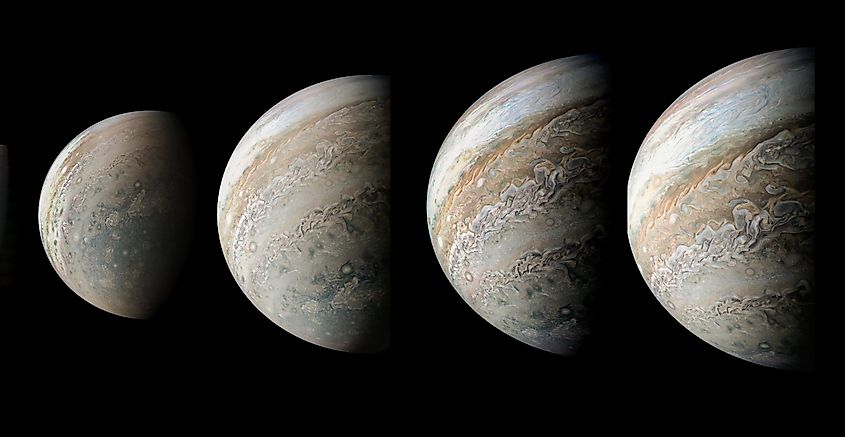
Since Jupiter is visible to the naked eye, its existence has been known since ancient times. The first recorded observations of Jupiter were made by Babylonian astronomers nearly 3,000 years ago. As one of the brightest objects in Earth's sky, cultures often associated Jupiter with the king of the gods. In Greek mythology, Jupiter was believed to be Zeus. The name Jupiter comes from the Roman equivalent of Zeus.
Before the invention of the telescope, astronomers had no way of learning anything about Jupiter. In 1610, everything changed when Galileo Galilei pointed his telescope toward Jupiter. Galileo was not only the first person to observe another planet through a telescope, but he also discovered four moons in orbit around Jupiter. Galileo had found the first observational proof that the geocentric model of the universe was incorrect. Galileo had found evidence that not everything orbited the Earth. Galileo's confirmation of the heliocentric model landed him in hot water with the Church, and unfortunately, Galileo was tried and sentenced to house arrest for the remainder of his life. Despite the Church's attempts to silence Galileo and his discoveries, Galileo had opened the floodgates of discovery. It was only a matter of time before other astronomers pointed their telescopes to the heavens.
In the 1660s, astronomer Giovanni Cassini used a more advanced telescope than the one Galileo had used. Cassini discovered large bands that stretched across the surface of Jupiter, as well as large spots that would later be identified as large storms. Cassini may have even observed Jupiter's Great Red Spot, although this disputed fact may or may not be accurate. The first detailed observation of the Great Red Spot was made by a pharmacist named Heinrich Schwabe in 1831, although its existence was likely known before this.
Jupiter is so far away from the Earth that even as telescopes continued to advance, very little was known about Jupiter. It wasn't until the 1970s that scientists sent robotic spacecraft to Jupiter to study the gas giant. The first mission to Jupiter was in 1973 with NASA's Pioneer 10 spacecraft. A year later, Pioneer 11 completed another flyby of Jupiter. Pioneer 10 and 11 gave scientists their first up-close views of Jupiter and offered the earliest information of Jupiter's atmosphere and physical characteristics. In 1979, Jupiter was visited twice, once by Voyager 1 and once by Voyager 2. The Voyager mission offered scientists the most detailed observations of Jupiter's four largest moons, dispelling some notions about moons and revealing that moons can be just as interesting as the planets they orbit. Unfortunately, these four spacecraft were only able to complete brief flybys of Jupiter. Although flybys offer a tremendous amount of data, they tend to raise more questions than they answer. In 1989, NASA launched the Galileo space probe, the mission of which was to become the first spacecraft to enter into orbit around Jupiter. In 1995, Galileo entered orbit and remained there for seven years. Galileo had also brought another probe along with it. This other spacecraft was deployed from Galileo and plunged into Jupiter's atmosphere, reaching speeds of 1,600 mph (2,575 km/h). The spacecraft managed to survive for nearly a full hour before the extreme conditions in Jupiter's atmosphere destroyed the spacecraft. To date, the Galileo mission revealed most of what is known about Jupiter, yet thankfully it was not the last mission to Jupiter. In 2016, NASA's Juno spacecraft entered into orbit around Jupiter and will remain there until 2025.
Does Jupiter Have A Solid Surface?
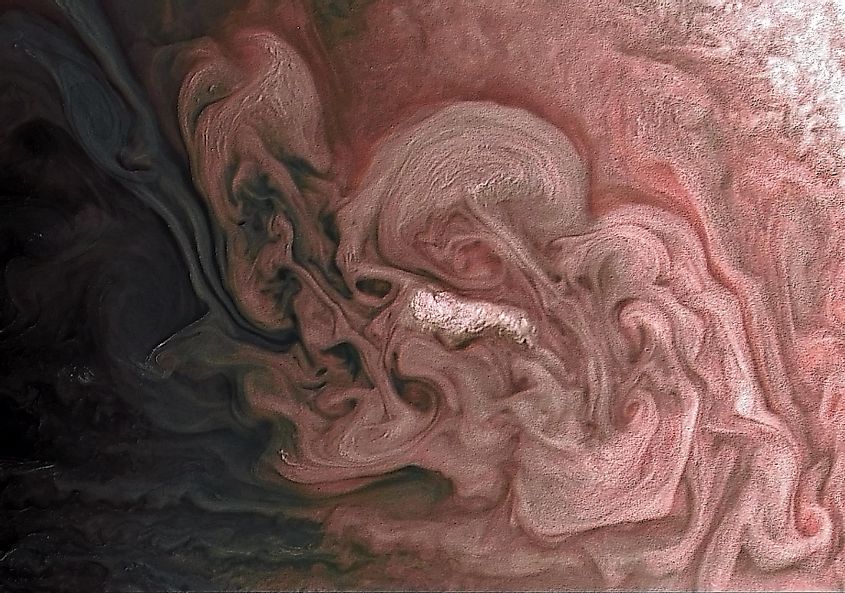
For decades, astronomers have puzzled over the interior of Jupiter. Does Jupiter have a solid core, or is it composed of gas all the way through? Evidence from the Juno spacecraft seems to indicate something that astronomers had not predicted. Rather than being solid or gaseous, the core of Jupiter is diluted, being composed of both heavy elements and rock, along with the lighter elements hydrogen and helium. Models of planet formation suggest that Jupiter began its life as a rocky world many times the mass of Earth. As Jupiter accumulated more mass, it became large enough to accrete lighter elements into its atmosphere. As Jupiter's mass continued to skyrocket, a process of runaway accretion took place. Thus, astronomers predicted that Jupiter either still possessed its rocky core or it had eroded over the last 4.5 billion years. To determine what the center is actually made of, Juno accurately measured Jupiter's gravitational field to determine its internal composition. Astronomers were astonished at what the data revealed. Jupiter's core is both rocky and gaseous. Astronomers had initially predicted that many lighter elements would be unlikely to exist at such extreme depths within Jupiter, mostly because heavier elements would sink to the interior. When Juno revealed that Jupiter's core is composed of both rocky material and lighter material, astronomers needed to revise models of Jupiter's formation. Astronomers now believe that Jupiter may have undergone a series of collisions with other forming planets. A head-on collision with a planet around ten times the mass of the Earth could explain Jupiter's diluted core. This theoretical super-Earth would contain about eight Earth masses of rock and ice, while it would contain two Earth masses of hydrogen and helium. As the forming world collided with the young Jupiter, it merged with Jupiter along with all its material. The resulting impact on Jupiter's core would produce a diluted interior composed of rock, ice, and lighter elements.
The Great Red Spot
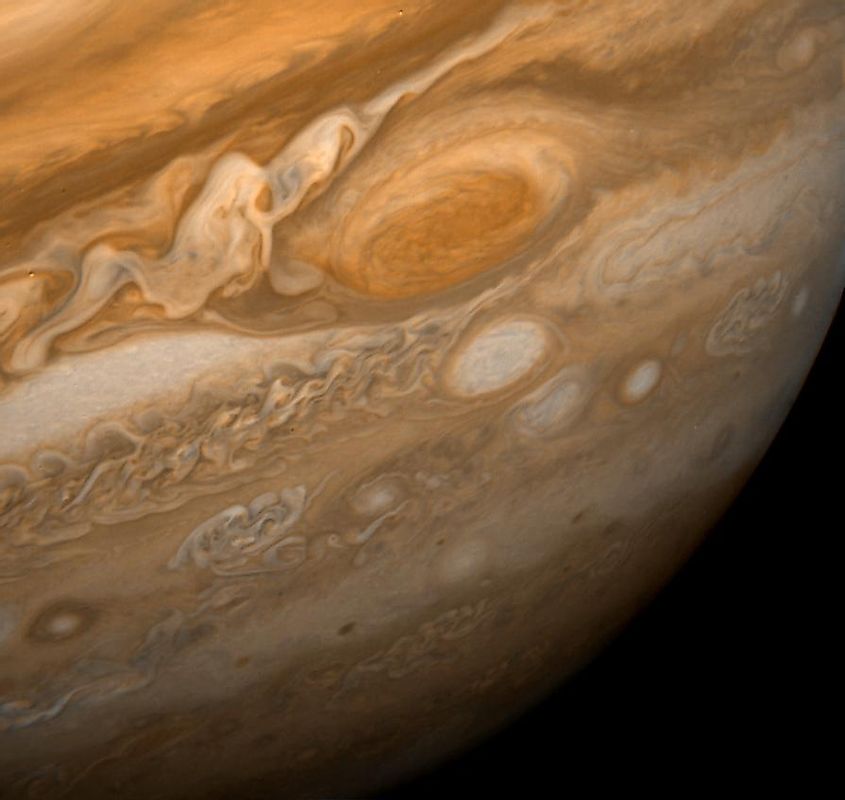
Natural disasters on Earth are a constant reminder of how destructive nature can be, yet what we experience on Earth, however destructive it may appear, is minuscule compared to the other worlds in our solar system. Jupiter is home to one of the most famous storm systems ever discovered: The Great Red Spot. The age of the Great Red Spot is not fully known, yet scientists know it has existed for at least the last 350 years. The earliest observations of the Great Red Spot date to the late 1600s, which suggests that this gigantic storm may have actually formed much earlier. The first up-close views of the Great Red Spot came in the 1970s with the Pioneer 10 spacecraft and the Voyager 1 spacecraft. They revealed a stunning storm that once measured 64,373 miles (40,000 kilometers) across, approximately three times larger than Earth. However, in the early 21st century, astronomers started observing a change in the solar system's largest storm. The Great Red Spot has shrunk by almost 50% in just the last 20 years, with some scientists predicting that the storm could someday disappear entirely. However, it's possible that what we can see as the Great Red Spot is merely just its upper layers. The underlying sections of the storm could still be their original size. Interestingly, the reason why the Great Red Spot is red is somewhat of a mystery. One explanation is that the Great Red Spot has an abundance of organic compounds called tholins, which labs on Earth have shown to emit a reddish color.
The Great Red Spot (GRS) is the biggest storm in the solar system, having a width of over 9,900 miles (16,000 kilometers). This makes it around 1.3 times larger than the Earth. Astronomers have been observing the GRS for centuries, yet to this day, how the GRS formed and why it's even red remain a mystery. That isn't to say there aren't some good theories, however. A study from 2018 revealed that the compound ammonium hydrosulfide could turn red under certain amounts of UV radiation.
Interestingly, scientists have discovered this same compound in Jupiter's atmosphere. Incoming solar radiation may turn ammonium hydrosulfide in Jupiter's atmosphere red. Furthermore, spectral analysis of ammonium hydrosulfide under UV light has revealed a similar composition and color to the GRS. However, there is enough difference between the two spectra that ammonium hydrosulfide likely isn't the only factor. Scientists have also found evidence that the GRS may contain organic compounds.
The GRS has a lower temperature than most of Jupiter's atmosphere. Strangely, the region just above the GRS is hotter than anywhere else in Jupiter's atmosphere. The exact cause of this excess heat remains a mystery. It's possible that sound waves produced by Jupiter's massive thunderstorms create friction in the region above the GRS, heating it to temperatures higher than its surroundings. The GRS has been shrinking over the last few decades for reasons that aren't fully understood. When the Voyager spacecraft visited Jupiter in the late 1970s, they found that the GRS was three times larger than the Earth. By 2004, the GRS had shrunk by nearly 50%. Astronomers are unsure whether these observations suggest the GRS is slowly disappearing or if these changes are normal fluctuations that have occurred in the past. If the shrinkage rate continues, the GRS may become circular by the 2040s.
Moons Of Jupiter
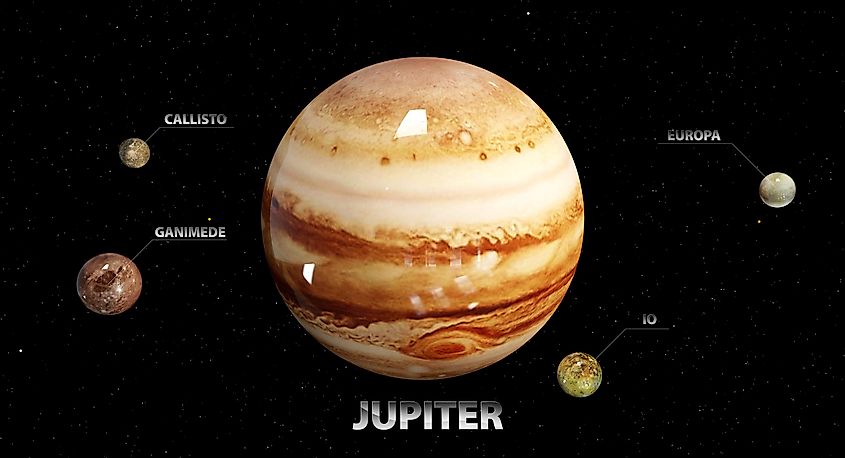
Jupiter is home to the second-largest system of moons in the solar system. There are believed to be 79 moons in orbit around Jupiter, yet not all of these are 100% confirmed. So far, Jupiter has 53 named moons. Most of these moons are small, cratered, barren worlds, yet the four largest moons of Jupiter are something else entirely. Ganymede is the largest moon of Jupiter and the largest moon in the solar system. It has a diameter of 5,268 miles (8,478 kilometers), making it larger than the planet Mercury. Ganymede looks somewhat like our moon, although it is much different. Ganymede is composed mainly of silicate rock and water ice. It has an iron-rich liquid core and likely has a subsurface ocean that harbors more water than Earth's oceans combined. The darker regions of the moon are covered in impact craters, while the lighter areas have fewer impact craters. Why these differences exist in Ganymede remains unknown. Ganymede has a very thin, oxygen-rich atmosphere containing O, O2, and O3 (ozone). Ganymede's discovery is credited to Galileo, who first observed the moon on January 7, 1610.
Callisto is one of the four Galilean moons of Jupiter, the second largest of Jupiter's moons, and the third-largest moon in the solar system overall. It has a diameter of 3,000 miles (4,821 kilometers), making it 99% the size of Mercury. Unlike the other Galilean moons, Callisto doesn't experience any tidal heating. Callisto's rotation is tidally locked with Jupiter, so the same hemisphere always faces Jupiter while the other side always faces away from the giant planet. Different compounds have been detected on the moon's surface, such as water ice, carbon dioxide, silicates, and organic compounds. Investigations by the Galileo spacecraft revealed that Callisto has a silicate core. The surface of Callisto is the oldest and most heavily cratered surface in the solar system. Callisto has no signs of any geological activity and no subsurface activities. It is believed that the moon has evolved primarily from the influence of impacts. Callisto has a very thin atmosphere composed of carbon dioxide and molecular oxygen. Callisto likely formed from accretion from a disk of gas and dust that would have surrounded Jupiter during its formation.
Io is the innermost of the four Galilean moons and is the fourth-largest moon in the solar system. It has the highest density of any moon and has the driest surface in the solar system. In 1979, the Voyager spacecraft discovered something that shocked scientists: the discovery of the first geologically active world other than Earth. Although the existence of Io had been known since Galileo, it wasn't until the Voyager missions that scientists learned that Io is geologically active. The moon has around 400 active volcanoes, making Io the most geologically active object in the solar system relative to its size. The extreme geological activity is likely due to tidal friction caused by Jupiter's gravitational pull and the pull of the other Galilean moons. Several of Io's volcanoes produce sulfur and sulfur dioxide plumes that can reach as high as 310 miles (500 kilometers). Some of Io's volcanoes have higher peaks than that Mount Everest. Io is primarily composed of silicate rock surrounding a molten iron core. This makes Io unique among the moons in the outer solar system because most moons are composed mainly of water ice rather than silicate rock. The extreme volcanism on Io is responsible for all of its geological features. Its large volcanic plumes alter the surface and paint it various colors, including yellow, red, black, and green.
When the Voyager spacecrafts sent back the first close-up images of Europa, astronomers were astonished at what they saw. Europa is one of Jupiter's many moons, having a diameter slightly smaller than our moon. Before the Voyager missions, astronomers had predicted that the moons of the outer solar system were likely to be similar in appearance to our moon. The understanding was that small bodies lose heat quickly after formation, so moons will expel most of their internal heat and become cold and dry. This is why our stereotypical view of moons is that they're grey and cratered. After all, most moons in our solar system are cold and dry. However, some seem to be straight out of science fiction. The outer solar system turned out to be home to a wide diversity of moons, with many of them being drastically different than anything astronomers could have predicted. Europa was one of these logic-defying moons.
When the Voyager spacecrafts sent back the first closeup images of Europa, astronomers were astonished at what they saw. Europa is one of Jupiter’s many moons, having a diameter slightly smaller than our moon. Prior to the Voyager missions, astronomers had predicted that the moons of the outer solar system were likely to be similar in appearance to our moon. The understanding was that small bodies lose heat quickly after formation, and so moons will expel most of their internal heat and become cold and dry. This is why our stereotypical view of moons is that they’re grey and cratered. After all, most moons in our solar system are cold and dry. However, there are some that seem to be straight out of science fiction. The outer solar system turned out to be home to a wide diversity of moons, with many of them being drastically different than anything astronomers could have predicted. Europe was one of these logic-defying moons. Closeup images of the surface revealed a world covered in cracks and fissures, along with a lack of impact craters. Europa is composed almost entirely of water-ice and silicate rock. The cracks streaking across Europa’s surface are regions where ice has broken apart, much like how sheets of ice melt and break apart from larger bodies of ice on Earth. This is a common observation in Antarctica, where warmer temperatures partially melt ice, causing it to crack and break apart at different times of the year. The fact that this was occurring on Europa surprised astronomers. These events occur on Earth because our world is warmed by both internal heat and heat from the sun. Europa is many millions of kilometres further from the sun than we are, and thus the sun could not be responsible for the melting of Europa’s ice. As it turned out, Europa is generating internal heat that travels outwards from the core. This heat warms and melts subsurface ice, creating an ocean of liquid water that could be 100 km in depth, far deeper than the deepest oceans on Earth. The cause of this internal energy was a mystery until astronomers looked to Jupiter for an answer. Like everything in an orbit, Europa travels around Jupiter in an ellipse. This means that Europa is closer to Jupiter at some points, while at others it’s further away. This change in distance also results in a change of how much gravity Europa experiences. When it’s further away, Jupiter pulls on Europa slightly less than when it’s closer. This change in gravitational energy literally flexes Europa back and forth in its orbit. This flexing generates friction within the core of Europa, which in turn releases heat that warms Europa’s interior. The heat travels outwards from the core and melts subsurface ice, creating a vast ocean of liquid water.
Close-up images of the surface revealed a world covered in cracks and fissures and a lack of impact craters. Europa is composed almost entirely of water-ice and silicate rock. The cracks streaking across Europa's surface are regions where ice has broken apart, much like how sheets of ice melt and break apart from larger bodies of ice on Earth. This is a common observation in Antarctica, where warmer temperatures partially melt ice, causing it to crack and break apart at different times of the year. The fact that this was occurring in Europa surprised astronomers. These events occur on Earth because our world is warmed by both internal heat and heat from the sun. Europa is many millions of kilometers further from the sun than we are, and thus the sun could not be responsible for the melting of Europa's ice. As it turned out, Europa generates internal heat that travels outwards from the core. This heat warms and melts subsurface ice, creating an ocean of liquid water that could be 100 km in-depth, far deeper than the deepest oceans on Earth. The cause of this internal energy was a mystery until astronomers looked to Jupiter for an answer. Like everything in an orbit, Europa travels around Jupiter in an ellipse. This means that Europa is closer to Jupiter at some points, while at others, it's further away. This change in distance also results in a shift in how much gravity Europa experiences. When it's further away, Jupiter pulls on Europa slightly less than when it's closer. This change in gravitational energy flexes Europa back and forth in its orbit. This flexing generates friction within the core of Europa, which in turn releases heat that warms Europa's interior. The heat travels outwards from the core and melts subsurface ice, creating a vast ocean of liquid water.
| Diameter | 88,846 miles (142,984 kilometres) |
|---|---|
|
Mass |
318 Earths |
|
Moons |
79 |
|
Rings |
4 |
|
Distance from the Sun |
484-million miles (778-million kilometres) |
|
Length of year |
4,329 Earth days |
|
Length of day |
10 hours |
|
Surface Temperature |
Minus 186 degrees Fahrenheit (minus 121 degrees Celsius) |
|
Atmospheric Composition |
90% hydrogen, 10% helium |
|
Surface Composition |
Hydrogen, helium, water ice |
|
Discovery Date |
Over 3,000 years ago |
|
Discovered By |
Babylonian astronomers |
